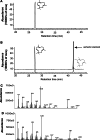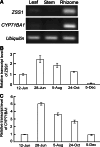Zingiber zerumbet CYP71BA1 catalyzes the conversion of α-humulene to 8-hydroxy-α-humulene in zerumbone biosynthesis
- PMID: 20730551
- PMCID: PMC11114803
- DOI: 10.1007/s00018-010-0506-4
Zingiber zerumbet CYP71BA1 catalyzes the conversion of α-humulene to 8-hydroxy-α-humulene in zerumbone biosynthesis
Abstract
Plant cytochrome P450s are involved in the biosynthesis of various classes of secondary metabolites. To elucidate the biosynthesis of zerumbone, a sesquiterpenoid with multiple potential anticancer properties, a family of P450 genes expressed in rhizomes of Zingiber zerumbet Smith, were cloned using a PCR-based cloning strategy. After functional expression in yeast, one of these P450s was found to convert α-humulene into 8-hydroxy-α-humulene, a proposed intermediate of zerumbone biosynthesis. This P450 has been designated CYP71BA1, a new member of the CYP71 family. CYP71BA1 transcripts were detected almost exclusively in rhizomes and showed a similar expression pattern to ZSS1 transcripts during rhizome development. Coexpression of a gene cluster encoding four enzymes of the mevalonate pathway with CYP71BA1 and ZSS1 in Escherichia coli leads to the production of 8-hydroxy-α-humulene in the presence of mevalonate, suggesting the possibility of microbial production of this zerumbone intermediate from a relatively simple carbon source by metabolic engineering.
Figures






Similar articles
-
Molecular cloning and functional characterization of alpha-humulene synthase, a possible key enzyme of zerumbone biosynthesis in shampoo ginger (Zingiber zerumbet Smith).Planta. 2008 May;227(6):1291-9. doi: 10.1007/s00425-008-0700-x. Epub 2008 Feb 14. Planta. 2008. PMID: 18273640
-
Efficient functional analysis system for cyanobacterial or plant cytochromes P450 involved in sesquiterpene biosynthesis.Appl Microbiol Biotechnol. 2011 Apr;90(2):467-76. doi: 10.1007/s00253-010-3062-9. Epub 2011 Jan 13. Appl Microbiol Biotechnol. 2011. PMID: 21229242
-
Production of sesquiterpenoid zerumbone from metabolic engineered Saccharomyces cerevisiae.Metab Eng. 2018 Sep;49:28-35. doi: 10.1016/j.ymben.2018.07.010. Epub 2018 Jul 19. Metab Eng. 2018. PMID: 30031850
-
A Review of the Biomedical Applications of Zerumbone and the Techniques for Its Extraction from Ginger Rhizomes.Molecules. 2017 Sep 30;22(10):1645. doi: 10.3390/molecules22101645. Molecules. 2017. PMID: 28974019 Free PMC article. Review.
-
Major Bioactive Compounds in Essential Oils Extracted From the Rhizomes of Zingiber zerumbet (L) Smith: A Mini-Review on the Anti-allergic and Immunomodulatory Properties.Front Pharmacol. 2018 Jun 20;9:652. doi: 10.3389/fphar.2018.00652. eCollection 2018. Front Pharmacol. 2018. PMID: 29973880 Free PMC article. Review.
Cited by
-
Traps and Pitfalls-Unspecific Reactions in Metabolic Engineering of Sesquiterpenoid Pathways.Molecules. 2020 Apr 22;25(8):1935. doi: 10.3390/molecules25081935. Molecules. 2020. PMID: 32331245 Free PMC article. Review.
-
A Syringa pinnatifolia genome assembly reveals the zerumbone biosynthesis machinery with a cytochrome P450-catalysed epoxidation reaction in eudicots.Plant Biotechnol J. 2024 Sep;22(9):2629-2631. doi: 10.1111/pbi.14376. Epub 2024 Jun 2. Plant Biotechnol J. 2024. PMID: 38824457 Free PMC article. No abstract available.
-
Plant cytochrome P450s: nomenclature and involvement in natural product biosynthesis.Protoplasma. 2016 Sep;253(5):1197-209. doi: 10.1007/s00709-015-0884-4. Epub 2015 Sep 12. Protoplasma. 2016. PMID: 26364028 Review.
-
Identification and Expression Analysis of Cytochrome P450 Genes Probably Involved in Triterpenoid Saponins Biosynthesis in Astragalus mongholicus.Int J Mol Sci. 2024 Jul 30;25(15):8333. doi: 10.3390/ijms25158333. Int J Mol Sci. 2024. PMID: 39125903 Free PMC article.
-
Transcriptome Profiling of the Resistance Response of Musa acuminata subsp. burmannicoides, var. Calcutta 4 to Pseudocercospora musae.Int J Mol Sci. 2022 Nov 5;23(21):13589. doi: 10.3390/ijms232113589. Int J Mol Sci. 2022. PMID: 36362377 Free PMC article.
References
-
- Dai JR, Cardellina JH, McMahon JB, Boyd MR. Zerumbone, an HIV-inhibitory and cytotoxic sesquiterpene of Zingiber aromaticum and Z. zerumbet . Nat Prod Lett. 1997;10:115–118.
-
- Ozaki Y, Kawahara N, Harada M. Anti-inflammatory effect of Zingiber cassumunar Roxb. and its active principles. Chem Pharm Bull. 1991;39:2353–2356. - PubMed
-
- Murakami A, Takahashi D, Kinoshita T, Koshimizu K, Kim HW, Yoshihiro A, Nakamura Y, Jiwajinda S, Terao J, Ohigashi H. Zerumbone, a Southeast Asian ginger sesquiterpene, markedly suppresses free radical generation, proinflammatory protein production and cancer cell proliferation accompanied by apoptosis: the α, β-unsaturated carbonyl group is a prerequisite. Carcinogenesis. 2002;23:795–802. doi: 10.1093/carcin/23.5.795. - DOI - PubMed
Publication types
MeSH terms
Substances
LinkOut - more resources
Full Text Sources
Molecular Biology Databases

